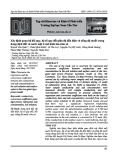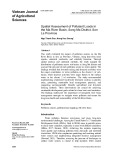
CAN THO JOURNAL OF SCIENCE AND TECHNOLOGY - No.05 - February, 2025
75
INORGANIC P SOLUBILIZATION BY MICROORGANISMS AND
THEIR POTENTIAL APPLICATIONS IN AGRICULTURE
Nguyen Thi Hong Xuyen
1
, Nguyen Xuan Hong
1
, Doan Phuong Linh
1
,
Nguyen Hoang Oanh
2
, Nguyen Kieu Nhu
2
, Nguyen To Kha Ai
2
, and Lieu Tu Duyen
2
1Can Tho University of Technology
2Student of the Faculty of Biological, Chemical and Food Technology, Can Tho University of Technology
Email: nthxuyen@ctuet.edu.vn
ARTICLE INFO
Received: 06/01/2025
Revised: 03/02/2025
Accepted: 10/02/2025
Keywords:
Organic phosphorus Inorganic
phosphorus
Phosphate-solubilizing
microorganisms (PSM)
Phosphorus
Sustainable agriculture
ABSTRACT
Phosphorus (P) is essential for plant growth, but most of it in soil
is insoluble and unavailable to plants. To increase crop yields,
farmers use chemical fertilizers, causing soil pollution from the
accumulation of insoluble P. Beneficial microorganisms called
phosphorus-solubilizing microorganisms (PSMs) can change
insoluble organic and inorganic phosphorus compounds into forms
that plants can absorb. PSM offers an environmentally friendly and
economically viable solution to address phosphorus deficiency and
the limited P uptake in plants. Although PSM have been a research
focus for decades, their application to increase soluble P in soil and
improve crop productivity remains a topic of active study. This
article seeks to deepen knowledge of how PSM can improve plant
growth, decrease soil phosphorus contamination, and contribute to
the future of sustainable agriculture.
1. INTRODUCTION
Sustainable agriculture is a solution to the
food scarcity and hunger crises. According to
the Food and Agriculture Organization (FAO,
2005), over 923 million people suffer from
chronic hunger. Furthermore, this number is
expected to rise to 9.3 billion by 2050
(Kishore et al., 2015). In light of this, a key
requirement for an agricultural revolution is
the utilization of underutilized or non-arable
lands (low-yield lands) to expand crop areas.
High agricultural yields depend on crop
productivity and soil fertility. One of the main
factors that reduces crop yields is nutrient
deficiency. Various metabolic processes in
plants at any growth stage can be affected by
a lack of or unavailable nutrients in the soil.
Plants with different genotypes vary in their
ability to absorb nutrients from the soil by
converting non-assimilable substances into
assimilable forms. In general, factors such as
low solubility, poor mobility, or inherently
low nutrient concentrations in different soil
types cause nutrient deficiencies (Sessitsch et
al., 2018).
Essential plant nutrients are relatively
high, but their concentrations in the soil are
insufficient to meet plant growth demands.
Nutrients such as phosphorus (P), potassium
(K), iron (Fe), zinc (Zn), manganese (Mn),
and copper (Cu) have limited solubility in
soil. They are transported into the roots
through processes such as diffusion, osmosis,
active transport, or xylem transport. Nitrogen
(N), phosphorus (P), and potassium (K) are
among the key micronutrients necessary for
plant development. Among these, nitrogen is
abundantly available from the atmosphere.

CAN THO JOURNAL OF SCIENCE AND TECHNOLOGY - No.05 - February, 2025
76
Phosphorus is essential for the formation of
molecules like DNA (deoxyribonucleic acid),
RNA (ribonucleic acid), and phospholipids in
both plant and animal cells. After nitrogen,
phosphorus is the second limiting nutrient in
agricultural production. Root surface area,
crop , yield, and disease resistance influence
plants' uptake of nutrients, directly or
indirectly. Phosphorus also plays a crucial
role in photosynthesis, sugar breakdown,
nutrient absorption, and transport. Plants
deficient in phosphorus will experience slow
growth (Sharma et al., 2013).
Moreover, soil only utilizes about 30% of
chemical phosphate fertilizers while the
remaining phosphorus is fixed as
iron/aluminium phosphate in acidic soils or
as calcium phosphate in neutral and alkaline
soils (Lindsay et al., 1989). Studies have
shown that the phosphorus accumulated in
agricultural soils would be sufficient to
maintain maximum crop yields worldwide
for about 100 years if it were in a soluble
form (Khan et al., 2009). Furthermore, only
1% of the total phosphorus in soil (400–
4,000 P kg/ha in the top 30 cm) is absorbed
by plants in each growing season (10–30 P
kg/ha), indicating that the available
phosphorus for plant uptake is very low
(Blake et al., 2000). On the other hand,
phosphorus is a finite resource, and based on
current usage rates, it is estimated that global
phosphorus reserves may be depleted in the
next century (Cordell et al., 2009). Thus, the
recognition of these underlying issues has led
to the search for environmentally compatible
and economically feasible alternative
strategies to improve crop production in
phosphorus-deficient soils (Zaidi et al.,
2009). The use of phosphorus-solubilizing
microorganisms (PSMs) in agricultural soils
is considered an environmentally friendly
alternative. Using PSMs as bio-fertilizers to
enhance agricultural crop yields has become
an emerging research topic. This article aims
to provide some insights into the existence of
phosphorus in soil, the diversity of PSMs,
phosphorus solubilization mechanisms, and
their potential applications in sustainable
agricultural production.
2. PHOSPHORUS-SOLUBILIZING
MICROORGANISMS (PSMS)
Currently, scientists have discovered many
microbial species capable of phosphorus-
solubilizing, including bacteria, fungi,
actinomycetes, and even algae. Pseudomonas
and Bacillus are two common bacterial genera
known for their phosphate-solubilizing
abilities. Other bacterial genera capable of
solubilizing phosphate include Rhodococcus,
Arthrobacter, Serratia, Chryseobacterium,
Gordonia, Phyllobacterium, Delftia sp. (Chen
et al., 2003), Azotobacter (Kumar et al.,
2001), Xanthomonas (De Freitas et al., 1997),
Enterobacter, Pantoea, Klebsiella, Vibrio
proteolyticus, and Xanthobacter agilis (Chung
et al., 2005). Additionally, nitrogen-fixing
Rhizobia, which converts atmospheric
nitrogen into ammonia and transfers fixed
nitrogen to the host plant, has also shown
phosphate solubilizing activity (Zaidi et al.,
2009). For example, Rhizobium
leguminosarum bv. Trifolii (Abril et al.,
2007), and Rhizobium, Crotalaria improve
phosphorus nutrition in plants by mobilizing
both inorganic and organic phosphorus.
Researchers have isolated different phosphate-
solubilizing bacteria (PSB) from nutrient-
deficient environments, such as the halophilic
bacterium Kushneria sinocarni, isolated from
coastal sediments on the eastern coast of
China, which is beneficial for agricultural
soils affected by salt (Zhu et al., 2011).
In soil, phosphate-solubilizing fungi (PSF)
account for about 0.1–0.5% of the total fungal
population. Furthermore, PSF retains their
phosphate-solubilizing activity even after
researchers repeatedly subculture them under

CAN THO JOURNAL OF SCIENCE AND TECHNOLOGY - No.05 - February, 2025
77
laboratory conditions, unlike phosphate-
solubilizing bacteria (Kucey, 1983). Generally,
PSF produces more acids than bacteria and
exhibits greater phosphate solubilizing activity
(Venkateswarlu et al.,1984). Among the
phosphate-solubilizing fungi, the genera
Aspergillus and Penicillium are the most
common (Khan & Khan, 2002), Trichoderma
strains (Altomare et al., 1999) and Rhizoctonia
solani (Jacobs et al., 2002) are also known to
solubilize phosphate. Of the identified fungal
species, many commonly found in agricultural
soils, such as Penicillium sp., Mucor sp., and
Aspergillus sp. have been shown to increase
plant growth by 5-20% (Güneş et al., 2009).
Vassilev et al. (2001) have also studied yeasts
capable of phosphate solubilization, such as
Yarrowia lipolytica, Schizosaccharomyces
pombe, and Pichia fermentans.
The phosphate solubilizing ability of
actinomycetes has attracted attention because
this group of microorganisms not only
survives in harsh environments, such as
extreme heat but also has other potentials,
such as producing antibiotics and
phytohormones (Kucey, 1983), which can
simultaneously benefit plant growth (Hamdali
et al., 2008)). A study by Hamdali et al.
(2008) showed that about 20% of
actinomycetes can solubilize phosphate,
including species from the common genera
Streptomyces and Micromonospora. In
addition to bacteria, fungi, and actinomycetes,
algae, cyanobacteria, and mycorrhiza have
also demonstrated phosphate-solubilizing
activity (Widada et al., 2002).
3. MECHANISMS OF INORGANIC P
SOLUBILIZATION BY MICROORGANISMS
3.1. Producing organic acids
PSMs (phosphorus solubilizing
microorganisms) can solubilize insoluble
phosphate by secreting various organic
acids. These organic acids lower the pH,
enhance the process of metal cation binding
with phosphorus, form metal-phosphate ion
complexes, and compete with phosphorus
for adsorption sites. Organic acids are
produced either through direct oxidation or
mainly by oxidation and fermentation of
organic carbon sources. These acids can
directly solubilize phosphate or form
complexes with Fe, Al, and Ca ions that are
bound to phosphorus. Organic acids such as
gluconic acid, oxalic acid, citric acid, lactic
acid, tartaric acid, aspartic acid, etc., have
been identified in studies using high-
performance liquid chromatography
(HPLC). Research results indicate that
there is no direct correlation between the
amount of acid produced and the amount of
phosphorus released. The complex-forming
ability of organic acids plays a crucial role
in solubilizing insoluble inorganic
phosphate (Sharma et al., 2013). In a study
by Kucey (1983), it was demonstrated that
the addition of 0.05 M EDTA to the culture
medium of Penicillium balaji resulted in
higher phosphate solubilization. Adding
NaOH, on the other hand, inhibited the
phosphate solubilizing activity of
Rhizobium bacteria, which is related to 2-
ketogluconic acid. This study emphasizes
that the phosphate solubilization by
microorganisms is mainly due to their
ability to lower the pH of the environment.
3.2 Reducing soil pH
Researchers have studied phosphate
solubilization through cation acidification in
various bacterial and fungal species.
However, research on phosphate
solubilization through alkalinization remains
limited. The secretion of organic acids by
phosphate-solubilizing microorganisms
(PSMs) is related to the release of protons
(H
+
), which lowers the pH (Maliha et al.,
2004). The release of protons or OH- ions by
PSMs can also affect soil pH. Acidification

CAN THO JOURNAL OF SCIENCE AND TECHNOLOGY - No.05 - February, 2025
78
and pH reduction are not the only
mechanisms involved in phosphate
solubilization, as lowering the pH does not
always correlate with the amount of soluble
phosphorus. High-performance liquid
chromatography (HPLC) analysis of
Pseudomonas sp. culture filtrate showed no
formation of organic acids. Park et al. (2009)
proposed that phosphate solubilization occurs
through the secretion of ammonium ions
(NH
4+
) during nitrogen assimilation.
3.3. The release of protons (NH
4+
)
through assimilation and respiration
The amount of NH
4+
protons released
affects soil pH, and microorganisms produce
them through the utilization of nitrogen
sources. Among various nitrogen sources such
as asparagine, sodium nitrate, potassium
nitrate, urea, and calcium nitrate,
microorganisms that use NH
4+
as the sole
nitrogen source exhibit higher phosphate
solubilization compared to those using nitrate
(NO
3−
) (Sharan et al., 2008). The release of
NH
4+
protons could be the sole mechanism for
phosphate solubilization in some
microorganisms. However, no studies have
shown changes in pH or the amount of soluble
phosphorus in other microorganisms. Park et
al. (2009) suggested that other solubilization
mechanisms exist. They also proposed that the
release of NH
4+
protons depends on different
mechanisms. Only a portion of assimilated
NH
4+
is involved in phosphate solubilization.
3.4. Producing inorganic acids and H
2
S
Inorganic acids such as HCl, H
2
SO
4
, and
HNO
3
are related to phosphate solubilization.
Researchers have shown that Enterobacter
agglomerans can solubilize phosphate in the
form of hydroxyapatite via HCl mediation.
Kim et al. (1997) studied E. agglomerans and
genetically modified E. coli, and the results
showed that adding acids such as HCl, citric
acid, oxalic acid, and lactic acid to the culture
medium increased phosphate solubilization
from hydroxyapatite, although citric acid was
more effective in solubilizing phosphate than
HCl. Strains of Nitrosomonas and
Thiobacillus produce HNO
3
, H
2
SO
4
, and
solubilize phosphate. The release of inorganic
phosphorus through H
2
S is another
mechanism. Some bacteria that produce H
2
S
react with iron phosphate, forming iron sulfate
and releasing phosphorus. The sulfur
oxidation process of these microorganisms
increases the solubility of mineral phosphate
by producing H
2
SO
4
, nitrate, and CO
2
.
However, these mechanisms are less accepted
than the organic acid-mediated phosphate
solubilization mechanism.
3.5. The indirect degradation pathway
Halvorson et al. (1990) suggested that
rhizosphere microorganisms assimilate a large
amount of phosphorus from the soil through
absorption mechanisms. As a result, the
balance between insoluble and soluble
phosphorus is disrupted. Therefore, less
soluble phosphate is lost indirectly. The
soluble phosphorus inside PSMs cells is
balanced with insoluble phosphorus, as the
phosphorus content of microorganisms
correlates with the breakdown of phosphorus-
containing organic matter in the substrate.
Although plants and other soil organisms will
use some of the phosphorus released by PSMs
degradation, environmental changes cause
cells to die and release free phosphorus.
Starvation, predation, drought, high humidity,
freezing, or thawing can lead to a sudden
increase in available phosphorus due to an
unusually high rate of bacterial cell lysis
(Butterly et al., 2009).
3.6. Direct degradation pathway
Goldstein (1995) proposed that phosphate
solubilization primarily occurs through the
extracellular oxidation process of PSMs in
soil, with calcium phosphate providing a

CAN THO JOURNAL OF SCIENCE AND TECHNOLOGY - No.05 - February, 2025
79
significant amount of insoluble mineral
phosphorus. Biochemical analyses on pH
reduction and phosphate solubilization of
Burkholderia cepacia DA 23 were conducted
by Song et al. (2008).
3.7. Releasing exopolysaccharide (EPS)
Microorganisms mainly produce EPS in
response to biofilm formation and biological
stress. Microbial EPS are carbohydrate
polymers secreted by certain bacteria and
fungi on the outer surface of their cell walls.
Previous studies have shown that EPS can
form complexes with metals in soil (with the
order of affinity Al
3+
> Cu
2+
> Zn
2+
> Fe
3+
>
Mg
2+
> K
+
and play a role in phosphate
solubilization in soil (Zaidi et al., 2009).
Microbial EPS stimulates the release of
tricalcium phosphate (TCP) through
resonance with organic anions. Four PSB
strains, such as Enterobacter sp. (EnHy-
401), Arthrobacter sp. (ArHy-505),
Azotobacter sp. (AzHy-510), and
Enterobacter sp. (EnHy-402), were
evaluated for their EPS role in solubilizing
insoluble phosphate. The solubilization rate
depends on the microbial source and EPS
concentration (Yi et al., 2008).
3.8. Siderophore formation
Siderophores are iron-chelating
compounds produced by most
microorganisms in response to iron
deficiency. Microorganisms produce these
low-molecular-weight compounds (<10,000
Da) to combat stress under low iron
conditions. Researchers have identified
around 500 different siderophores, which
plants and microorganisms utilize. Some
PSMs also produce siderophores (Collavino et
al., 2010).
4. POTENTIAL APPLICATIONS OF
PSMS IN THE FUTURE
4.1. Use of PSM
Many studies have demonstrated the
beneficial effects of PSMs when used alone.
Lucy et al. (2004) found that stable
phosphorus (P) uptake influences the growth
and development of different crops. The
success of microbial formulations depends
mainly on their ability to colonize plant roots
and survive competition with native
microorganisms. Numerous studies have
reported the positive impact of individual
PSM species on plant growth. Phosphate
solubilizing characteristics in bacteria such as
Rhizobium and Azotobacter are examples of
nitrogen-fixing microorganisms (Kumar et al.,
2001). The effectiveness of phosphorus-
solubilizing fungi (PSF) in enhancing
inorganic phosphorus (Pi) availability for
plant uptake and growth depends on soil type,
especially the soil's ability to adsorb Pi. PSF
studied individually or in combination with
other fungi, can promote the development of
crops such as mung bean, maize, wheat, faba
bean, lentils, rice, and soybean. When
combined with rock phosphate (RP) sources
such as Mussoorie, Telesmi, etc., PSF is more
effective in providing phosphorus and
boosting growth, seed production, shoot
height, seed weight, nitrogen and phosphorus
accumulation, dry matter yield, root length,
and root productivity.
4.2. Use of multiple phosphate
solubilizing microorganisms (PSMs)
Both nitrogen (N) and phosphorus (P)
are essential nutrients for plants. Combining
nitrogen-fixing microorganisms with
phosphate-solubilizing microorganisms
(PSMs) can provide more significant
benefits to plants than using each group
alone. Nitrogen-fixing microorganisms like
Rhizobium and PSF significantly impact
crops such as wheat, mung beans, fava
beans, peas, and others, improving seed
yield, growth, and nutrient (N and P) uptake
compared to control samples without the


























